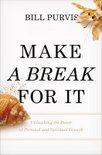Bill
Purvis. Make a Break for It: Unleashing the Power of Personal and Spiritual
Growth. Grand Rapids, MI: Zondervan,
2016. 216pp. $21.99.
According
to the Merriam-Webster Dictionary,
one defines “direction” as “the path along which
something moves, lies, or points” or “an order or instruction to be followed.”
Both are fitting definitions when
applied to the realm of spiritual development.
On one hand, we, from the moment we are born to the moment we expire,
are moving along a direction. We have a
starting point (mine was in December 1978, in Huntington, West Virginia), and
we have will have a stopping date (still working on that one). The time in between our starting point and
our stopping point is the direction of our life, or “trajectory,” as one of my
college Bible professors referred to. We
begin, we move along for a while, then we end.
Direction.
On the other
hand, we, from the moment we are born to the moment we expire, are following
directions. Some of those directions are
instinctual (crying when we are spanked at birth), some of those directions are
intentional (the directions that I give my students in order to complete a
paper or project), and some of those directions are accidental (pointing
blindly at a wrench when fixing an appliance and your son actually brings you
the correct item). Regardless of the
purpose of the direction, we will find ourselves following directions
throughout the course of our direction of life.
We begin, we move along for a while, then we end. Direction.
Yet, should
life not be more than simply follow directions as we follow along a direction? This is the idea that is at the heart of Bill
Purvis’ new book Make a Break for It. As he writes in the introduction, “Do you
ever feel as if your whole life is stuck in a traffic jam, on idle as you wait.
. .and wait. . .and then wait some more for a lane to open up so you can get on
the fast track to where you want to be?
Or maybe you feel more like you’re in a roundabout. You keep going around in circles, driving
past one exit after another because you don’t have any idea where you’re
supposed to go next” (p. 11). As Purvis
argues throughout his book, life should be more than beginning, moving along
for a while, and then ending.
Purvis’
story begins somewhat like you would imagine a published testimony to start—a young
man trapped in a broken life fueled by vices.
Yet Purvis’ story is not your usual testimony material. His testimony includes being stabbed in the
heart by a pimp who tried to murder him and his friend. Just let that line sink in for a moment. Escaping that moment led Purvis to a true “come
to Jesus moment”—a hospital bed confessional that leads to a young man
committing his life to not only follow Christ but seek to lead others to
Christ.
However, before you part company with Purvis 20 pages in
because you—like me—have a boring testimony, I encourage you to stick with
him. This is not Augusten Burroughs’ This Is How, a brash, abrasive therapy
session where you almost feel guilty for not being more broken. [BTW, I like Burroughs’ book.] Nor does this delve into sappy sentimental
religiosity. The chapters that follow
Purvis’ testimony are carefully-crafted conversations about life, redemption
and the self-sacrificial love of God. It
is a book about living well, about moving past excuses and criticisms, about
choosing mentors well, and about living the adventure of life.
This book is about direction—about beginning, about moving
along for a while, and about ending. Yet,
Purvis argues, all of this direction should be taken with purpose—purpose which
is found in God because it is only God who can give us direction for our
direction in life. So, in Purvis’ words,
make a break for it—break away from your direction-less life and allow this
redeemed journeyman guide you to a better direction for your life.
